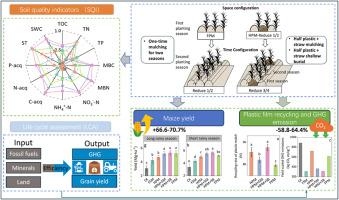Weakening plasticulture boosts maize productivity while improving environmental benefits in drying east African Plateau
IF 10
1区 环境科学与生态学
Q1 ENGINEERING, ENVIRONMENTAL
引用次数: 0
Abstract
Full plastic mulching (FPM) agriculture (plasticulture) demonstrates enormous yield-increasing potential in east African Plateau (EAP), yet its environmental effect is much questioned. Here, we examined the effectiveness of reducing plastic mulching in maize fields (2023–2024). Relative to non-mulching (CK), FPM significantly improved soil hydrothermal status, harvesting greater yield by 28.6–73.6 % (p < 0.05). Yet, it caused increasing plastic residues, evidently damaging soil structure & microbial activities, and generating 13.2 % higher emission of greenhouse gas (GHG). Strategically, half plastic mulching with half straw incorporation (mulching on or embedding in soil) significantly can reduce evapotranspiration loss by 9.4 %, and improve water use efficiency (70.8 %), soil organic carbon (4.4 %) and microbial activities relative to CK, respectively. Critically, it harvested considerable economic benefits exceeding those under FPM (p < 0.05), while lowering GHG emission intensity, and promoting recovery rate of plastic film (up to 95.1 %), relative to FPM. Therefore, weakening plasticulture can improve crop productivity while enhancing environmental benefits in EAP.

弱化塑料栽培可以提高玉米产量,同时改善干旱的东非高原的环境效益
全塑料覆盖农业(FPM)在东非高原(EAP)显示出巨大的增产潜力,但其对环境的影响却备受质疑。在此,我们研究了2023-2024年玉米田减少塑料覆盖的有效性。与不覆盖(CK)相比,FPM显著改善了土壤热液状态,产量提高28.6% ~ 73.6% (p <;0.05)。然而,它造成了塑料残留的增加,明显破坏了土壤结构。微生物活动,温室气体(GHG)排放量增加13.2%。与对照相比,半地膜+半秸秆还田(覆盖或埋地)可显著降低土壤蒸散损失9.4%,提高水分利用效率(70.8%)、土壤有机碳(4.4%)和微生物活性。关键的是,它比FPM获得了可观的经济效益(p <;0.05),同时降低了温室气体排放强度,提高了塑料薄膜的回收率(相对于FPM可达95.1%)。因此,弱化塑料栽培可以在提高EAP作物生产力的同时提高环境效益。
本文章由计算机程序翻译,如有差异,请以英文原文为准。
求助全文
约1分钟内获得全文
求助全文
来源期刊

Journal of Cleaner Production
环境科学-工程:环境
CiteScore
20.40
自引率
9.00%
发文量
4720
审稿时长
111 days
期刊介绍:
The Journal of Cleaner Production is an international, transdisciplinary journal that addresses and discusses theoretical and practical Cleaner Production, Environmental, and Sustainability issues. It aims to help societies become more sustainable by focusing on the concept of 'Cleaner Production', which aims at preventing waste production and increasing efficiencies in energy, water, resources, and human capital use. The journal serves as a platform for corporations, governments, education institutions, regions, and societies to engage in discussions and research related to Cleaner Production, environmental, and sustainability practices.
 求助内容:
求助内容: 应助结果提醒方式:
应助结果提醒方式:


